David A. Weintraub is professor of astronomy at Vanderbilt University, and his new bookLife On Mars: What to Know Before We Goexplores the difficulties associated with getting humans to Mars.
We spoke to David about humanity's fascination with the Red Planet, and how close we are to setting foot on its barren surface.

Why is humanity so fascinated with Mars?
From early telescopic studies of Mars several hundred years ago - really from the get-go of the invention of the telescope - astronomers discovered that Mars has a rotation period that is almost the same as Earth, just a bit more than 24 hours.
A few decades later, they discovered that Mars has polar caps and that it has seasons.
The seasons are longer than Earth’s because Mars’s year is longer.
Mars’s rotation axis is tilted about the same as Earth’s, it’s a rocky planet with a solid surface and a thin atmosphere: these are all Earth-like qualities.
And Mars is far more Earth-like than any planet in the Solar System, which makes it so appealing.
Also, because it is so close, early astronomers with telescopes could more easily study Mars than other planets.
Venus is boring, because it has such thick clouds! We can’t see anything on Venus, even though it’s relatively near by.
Astronomers didn’t understand that until the 20th century, but they understood that they just couldn’t learn anything about Venus.
Jupiter and Saturn are much farther away, but Mars is close and it’s Earth-like.
Then in the 19th century in the early days of spectroscopy, astronomers 'discovered' - incorrectly I should point out - that Mars had a lot of water vapour, and appeared to have features on the surface that some 19th century astronomers decided were canals.
Mars does have water, but the 19th century observations that showed Mars had water were wrong!
Early astronomers thought Mars had vegetation too, didn't they?
They did! They certainly didn’t make any measurements that proved Mars has vegetation because, of course, Mars doesn’t have vegetation, but the early observations of Mars in the 19th century were mostly focussed on the colours of Mars.
The dark colours were interpreted as vegetation, which is puzzling because the dark colours on the Moon are not interpreted as vegetation.
However, because astronomers already had in their minds an idea that Mars was Earth-like, they just decided that the dark colours meant plants.
The red colours seemed to indicate plant life on the surface, but these red colours are actually surface features and are also often dust storms.
As these dust clouds form and swirl around Mars, it could appear as if the vegetation was expanding across the surface, which they took to mean that it was growing rapidly.
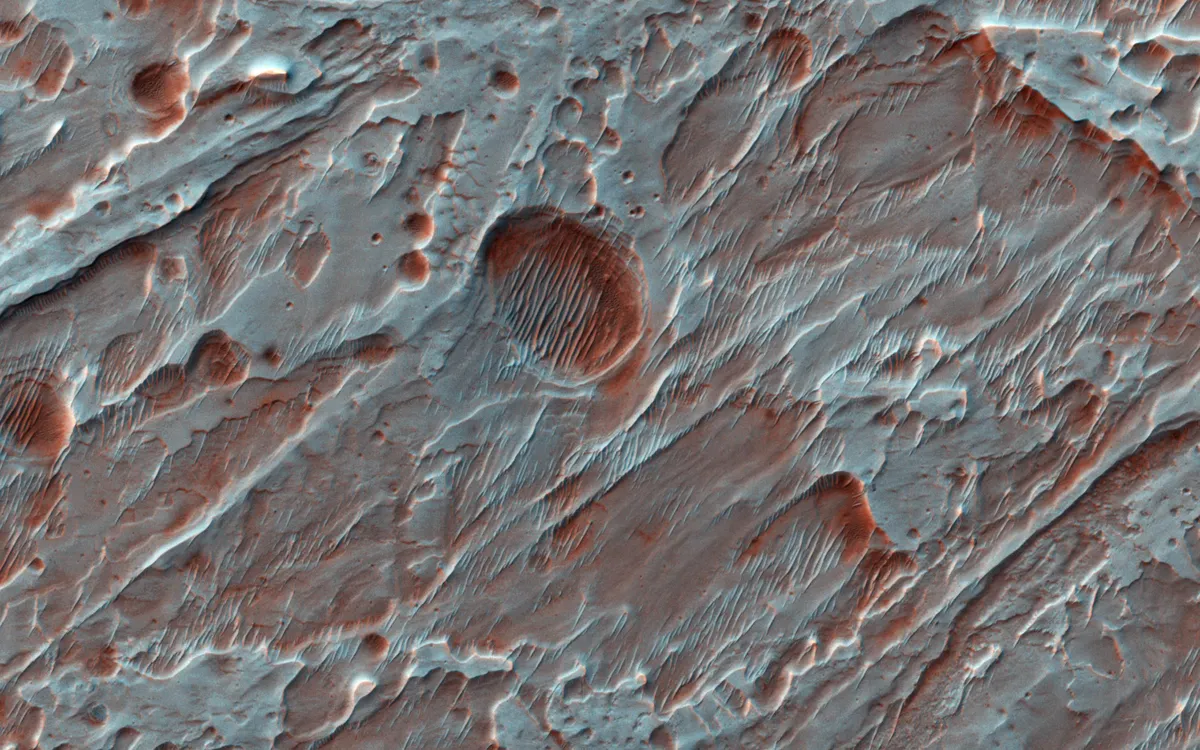
Since these early observations, we’ve been fascinated with the prospect of setting foot on the Red Planet.How close do you think we are to achieving that?
Given that Elon Musk’s Space X just launched a rocket that is going to Mars - even though it is going to go past Mars and not land on it - he’s on schedule, and he plans to send humans to Mars in 2024.
At this point, I wouldn’t doubt him.
I think it’s a very ambitious schedule, but he’s an ambitious entrepreneur and he could probably do it.
What do you think are the main obstacles to getting humans on Mars?
The main obstacle is building a rocket that’s big enough to send the pioneer astronauts, but which also has all the life support systems they need to keep them alive.
We’re good at sending rockets to Mars with rovers and telescopes, but those don’t have life support systems for astronauts. They don’t have the food, the oxygen tanks, everything that is needed to keep astronauts alive.
What’s needed is a bigger rocket, but I think these bigger rockets are moving forward in the design phase.
I think it’s likely we’ll have those rockets in the relative near term.
It might be a few years, it might be a decade or more, but we can certainly build them.
We don’t need something bigger than the Saturn V that brought astronauts to the Moon a generation ago; it just has to go further.
The obstacles are less about getting astronauts there, than they are keeping them alive and getting them back.
At the moment, I haven’t heard anything from Space X about getting the astronauts back.
They’re colonists who are going to Mars, they’re not adventurers who are going to Mars and planning to come home any time soon.
Keeping astronauts alive on the journey to Mars, I think, is doable.
Keeping them alive once they get to Mars for the long term: I think that’s a bigger challenge.

Isn't it the case that colonists on Mars would suffer from intense radiation?
That is the case. I don’t know offhand any estimates for how long someone might be able to stay alive, but the radiation from the Sun is very dangerous.
Some of those solar flares are impossible to avoid, and at the moment I don’t think we have the technology to shield astronauts in deep space from the intense energy of those solar flares.
I think a tremendous amount of research is being invested in figuring out how to enable astronauts to survive the harsh radiation environment of space, and on the surface of Mars it’s not much better than being in space in orbit around Mars.
And you’ve got to be able to survive that harsh environment for very extended periods of time.
We don’t know how to do that yet.
What about sustaining life by growing food on Mars? Is that possible?
I think The Martian movie was a great depiction of one imaginative way that could be done.
I think growing food on Mars is possible.
There are experiments already looking at growing food in space on the International Space Station, or how to grow food using a concoction that what we think Martian soil must be like.
I think it’s possible, but can we grow enough food, and quickly enough? I think the resources exist on Mars: we’ve got sunlight, carbon dioxide for plants, water.
You don’t need much more than that if you can actually get the process started.
You could imagine dropping habitats onto the surface of Mars, inside of which you could grow plants, you could have grow lights,you could manufacture soil.
I think it’s possible, but for how many people and for how long? These are serious problems that have to be solved.
Are there ethical considerations surrounding humans colonising Mars?
I think there are two very different ethical considerations. One is that, if we send colonists to Mars, can we keep them alive? If not, then I think we have an ethical problem in sending them.
If we can keep them alive and bring them home safely, that’s a different story. But if they’re just going to Mars to die, or if we’re sending them to Mars and we don’t have high expectations that we can keep them alive, I think that’s a seriously ethically compromised vision of what we should be doing.
The second consideration is whether we should be contaminating Mars. When we set food on Mars and start growing food, when we put substantial amounts of our DNA on the planet, we will contaminate it.
If Mars is a desert like the Moon, if it is sterile, then I think it doesn’t matter. If we’re just talking about landing on a rock with no life, then I don’t think there are any ethical issues.
I think we have to figure out whether there is any life on Mars before we land on the planet and try and colonise it. But if there is indigenous life, we have to think very hard about whether we have the right to colonise Mars.
If you look at the Cassini spacecraft at Saturn, we deorbited it into the planet because of the risk of allowing Cassini to crash into Titan or Enceladus. These are two moons of Saturn of which we know little about, other than that there is a possibility that they could harbour life because of their chemical makeup and the presence of liquid.
We don’t want to contaminate those worlds where there might be life, but Mars is an even better possibility for some kind of life, and we’re not talking about protecting Mars in the same way. I find that surprising.
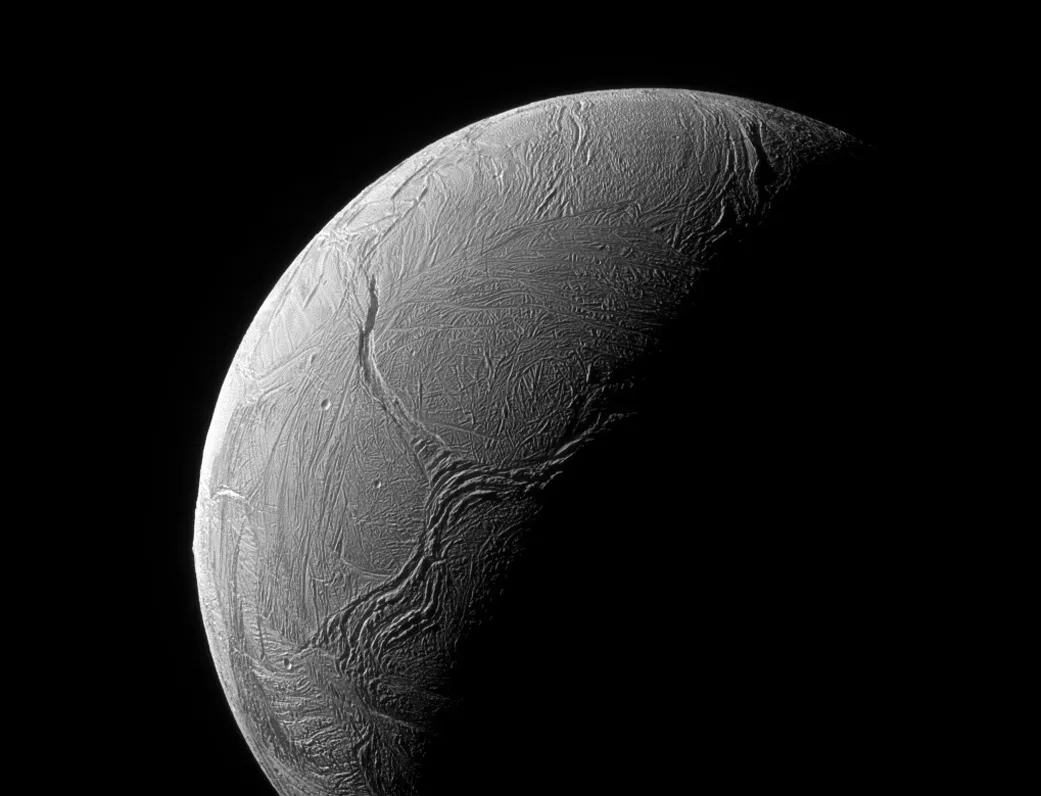
What would we do once we get to Mars?
The main thing would be proving that we can live on another planet. Learning how to grow food, how to manufacture the energy needed to survive, how to find water and melt it to survive: those are the first steps.
A second obvious step would be what science fiction writers have always called 'terraforming': trying to make Mars more hospitable for us. The atmosphere is almost entirely carbon dioxide, which is good for plants, but not for us.
So unless we’re just going to live in tents on Mars, we need to change the Martian atmosphere. I think most of the initial projects would be survivability.
Beyond that, Mars also has a lot of mineral reserves, which a lot of countries and companies on Earth would probably love to get their hands on!
Would you go on the first trip to Mars, even if it were a one-way trip?
A little bit of patience would enable us to reach the point at which our technology would give us confidence that an astronaut going to Mars is not sacrificing themselves.
When the early European explorers sailed to the ‘New World’, they were taking risks, but they didn’t think they were intentionally going off to die. I wouldn’t put myself in that situation, and I think with a little bit of patience we will be sending people off with a good chance that they will make it back.
Assuming my two ethical considerations were out of the picture, and that I could survive and come home, and that I were confident we had explored Mars and made sure it is sterile with no native life, then yeah I’d be eager to go!
I can’t think of anything more exciting than being one of the first humans to step on Mars. It’s a fascinating possibility.
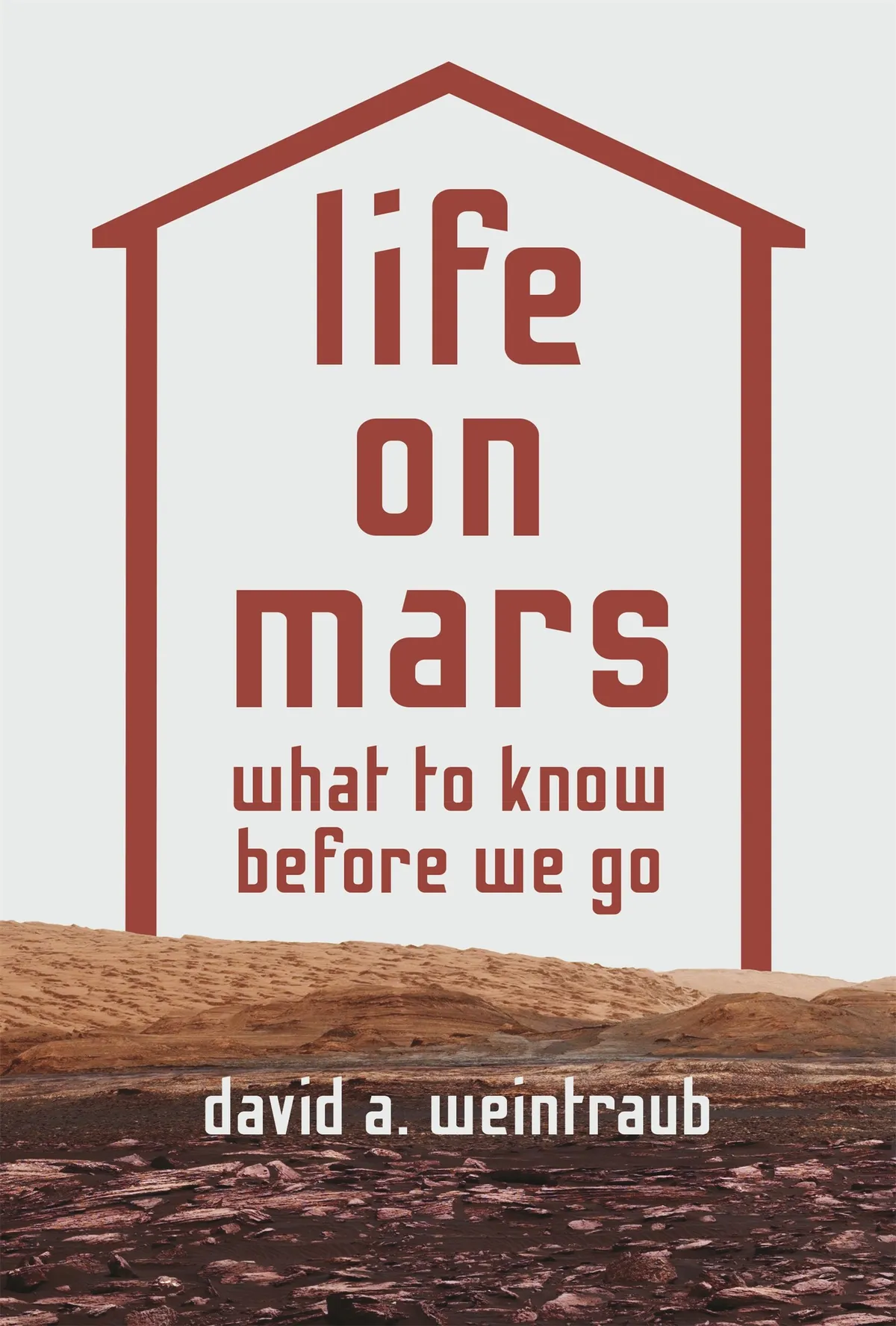
The following extract is from Life On Mars: What to Know Before We Go, by David A. Weintraub.
How soon might humans set foot on Mars?
NASA is developing the capabilities for sending humans to Mars and returning them safely to Earth by the 2030s.
Current plans include a first phase of exploration in the vicinity of the Moon, including building a spaceport in lunar orbit, which would be NASA's gateway to deep space.
NASA's human missions to Mars (and the Moon) will be launched from the Kennedy Space Center in Florida.
The Space Launch System (SLS), if completed, will be about 20% more powerful than the Saturn V rocket that supported the Apollo program for exploration of the Moon (the Saturn V could lift 135 tons into orbit) and will be built using the same, time-tested rocket technology developed for the Space Shuttle program.
The tremendous power of the SLS may eventually send astronauts to Mars in the Orion Multi-Purpose Crew Vehicle. The Orion would provide living space for the astronauts during the 16-month-long round-trip journey to Mars.
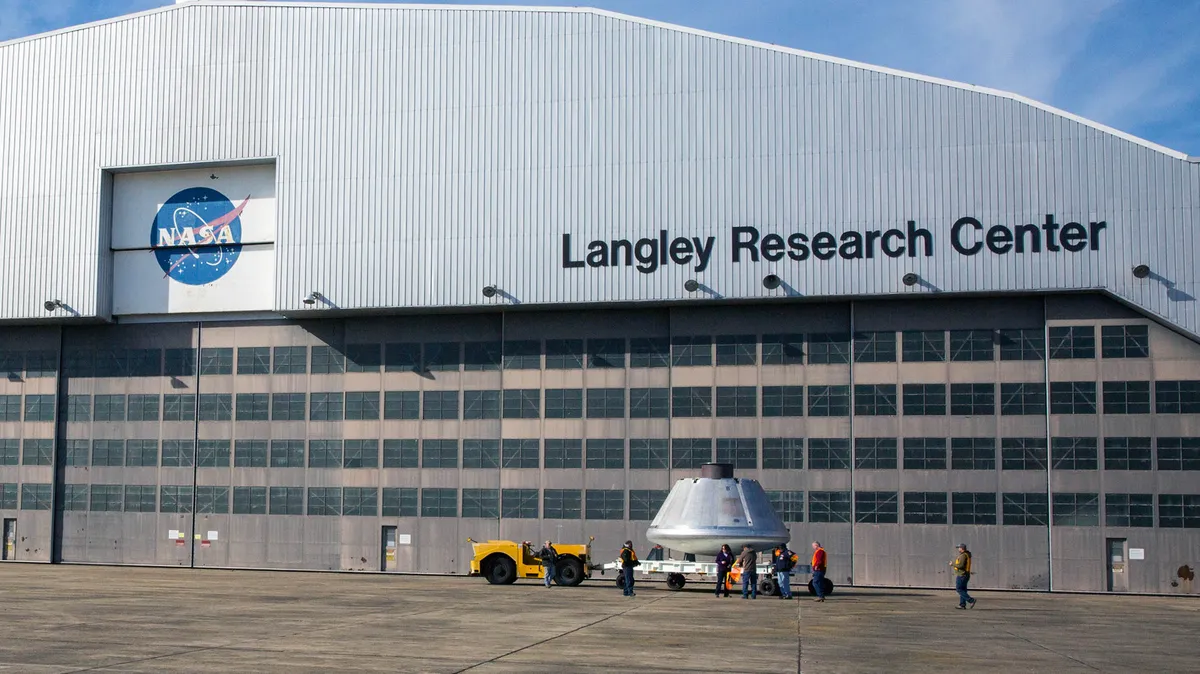
The first crewed flight of astronauts on Orion, Exploration Mission-2, was scheduled for 2021, but likely will be delayed.
The second phase of exploration, which includes plans for an eventual trip to Mars, will begin in the late 2020s with a planned one-year crewed mission to the lunar spaceport.
By the 2030s, NASA intends to have tested all the systems and capabilities of Orion necessary to carry astronauts and life-critical cargo to Mars's orbit and then return them to Earth.
Sending astronauts to Mars, landing them on the surface, keeping them alive, and then lifting them back off the Martian surface and returning them safely home remain well beyond NASA's current capabilities.
The downward pull of gravity at the surface of Mars is almost 2.5 times greater than the pull of gravity at the surface of the Moon. As a result, safely landing astronauts on Mars requires retrorockets or using some other lander design that will slow the downward acceleration of astronauts toward the surface of Mars.
For the same reason, blasting back off of Mars will be a much greater technological challenge than was returning astronauts from the surface of the Moon.
NASA, however, is no longer the only player in the exploration of space and the race to Mars. PayPal founder and entrepreneur Elon Musk made clear, when he founded his SpaceX corporation in 2002, that his goal was to establish a human colony on Mars.
Musk's planned launch vehicle, which has had several names, including the Interplanetary Transport System (ITS) and the BFR ('B' for 'big' and 'R' for 'rocket'), will be powered by thirty-one Raptor rocket engines, with a liftoff thrust of 5,400 tons (almost 11 million pounds), capable of lifting 150 tons into orbit.
The BFR will replace all the previous SpaceX rockets and spacecraft (Falcon 9, Falcon Heavy, Dragon).
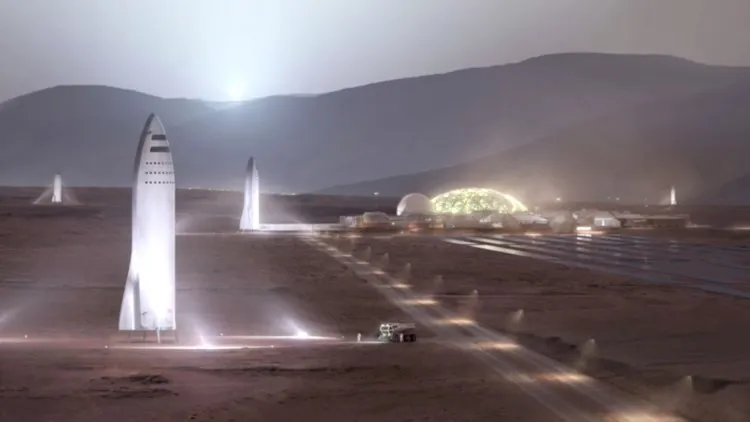
According to current plans, the Raptors, which are still in the design phase by SpaceX, will use carbon-fiber tanks holding (separately) liquid methane and liquid oxygen as fuel and will be able to refuel in space, which would enable the BFR to then take all 150 lifted tons all the way to Mars.
In 2022, Musk intends to use two ITS launches to send to and land two cargo payloads on Mars in Dragon spacecraft.
SpaceX intends to launch four rockets to Mars in 2024; two would ferry additional cargo and two would carry human crews with up to one hundred adventurers in each, who would arrive at and land on Mars, establish a colony, construct a propellant production depot, and find a supply of water.
Sci-Fi fans might note the similarity of Musk's plans to those described in Kim Stanley Robinson's 1990s award-winning trilogy Red Mars, Green Mars, and Blue Mars, in which the First Hundred colonists were launched to the red planet in 2026.
Over the next forty years, Musk wants to shuttle as many as a million colonists to Mars and to begin manipulating the Martian climate to make it more like that of Earth, a concept referred to as terraforming.
He claims that his Martians will be able to sustain themselves on Mars and also come home again, as his rockets will make regular round trips from Earth to Mars and back again.
The assumption that colonists will ever get back to Earth, however, depends first on their ability to survive the harsh radiation environment of space and on the surface of Mars, and then on the ability of SpaceX to use solar power to manufacture methane and oxygen fuels on Mars (from subsurface and atmospheric reservoirs of water and carbon dioxide) for return trips.
Another tech-billionaire, Amazon founder Jeffrey Bezos, is also building rockets through his venture Blue Origin and has his own plans for sending colonists to Mars.
In 2016, Blue Origin successfully launched and landed its first rocket, the New Shepard, named after the United States' first astronaut Alan Shepard, on a suborbital flight.
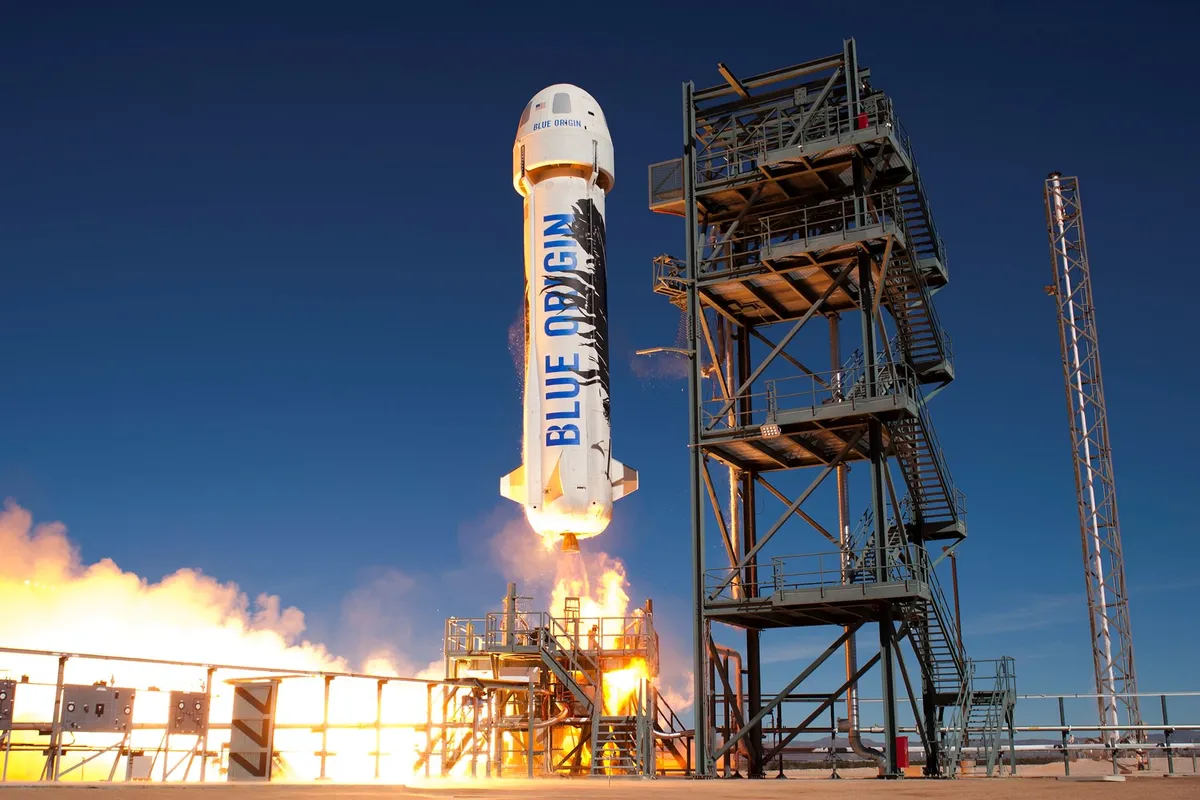
Blue Origin also is developing a more powerful rocket called New Glenn, named for the United States' first astronaut to orbit Earth, Mercury Seven astronaut John Glenn, which it intends to launch from a massive facility it has under construction at the Kennedy Space Center's Exploration Park.
Plans for New Glenn, which may debut in 2020, include a reusable first-stage rocket as part of a three-stage, 350-foot-tall launch vehicle that will burn liquid hydrogen and liquid oxygen.
Bezos expects his project to take many decades, rather than a single decade. First, Bezos expects his Blue Origin rockets to launch satellites and cargo, with a goal of delivering the equipment to the Moon that would be necessary to support a human colony there.
Then he intends to place millions of humans into space, where they will work in near-Earth orbit. Only then he will set his sights on placing colonists on both the Moon and Mars.
According to Bezos, "I think that if you go to the Moon first, and make the Moon your home, then you can get to Mars more easily."1
NASA may also have additional competition from a private Dutch group, Mars One2.
Founded in 2011 by Bas Lansdorp and Arno Wielders, Mars One intends to launch an unmanned mission to Mars in 2020, a first crew to Mars in 2031, and send a second crew in 2033.
In contrast to NASA, SpaceX, and Blue Origin, Mars One is not designing or manufacturing rockets, launch systems, landing modules, life support units, or rovers.
Instead, they intend to purchase everything they need from established aerospace companies. Whether Mars One can actually buy the mission hardware they need remains to be seen.
One other player has recently announced plans for colonizing Mars. In February 2017, at the World Government Summit in Dubai, Sheikh Mohammed bin Rashid Al Maktoum, ruler of Dubai and vice president of the United Arab Emirates, announced that the UAE planned to build a city on Mars within one hundred years3.
The UAE's Mars 2117 Project is only a concept for now; however, the UAE created its own space agency in 2014 and has plans to send an unmanned probe to Mars by 2021, coinciding with the fiftieth anniversary of the UAE gaining political independence from Great Britain in 19714.

The reason so many of us are so interested in Mars is that life on Mars is possible, whether for us in the future or for native Martians.
What if Mars harbors life today? What if astronauts establish a human colony on Mars in the twenty-first century?
Will we bring death and destruction to Mars, as the first European colonists did to the New World, when they brought smallpox, measles, whooping cough, bubonic plague, and dysentery to a world that lacked the ability to fend off those attackers?
They also brought horses and pigs that often outcompeted indigenous wildlife species for survival. Together, the Old World diseases and animals wreaked havoc on the biota of the New World.
Humanity also does not have a good track record in taking care of remote wilderness areas.
The ecosystems of the Arctic, Antarctic, and Amazon are all threatened by the encroachment of human civilization, by hunting and by global warming.
If we cannot find the collective will to help the polar bears, penguins, and giant otters survive on our own planet, will we do anything to help ensure the survival of microscopic Martians?
Do microscopic Martians even matter? Yes.
A second genesis, life that began completely independently of terrestrial origins, might have occurred there.
Even if life on Mars is limited to bacterial-sized beings, buried underground or hiding deep in a crevice where they are protected from dangerous ultraviolet radiation and cosmic rays and where they can find water, those microscopic Martians would be astoundingly important to our understanding of life in the universe.
Life on Mars that is independent of life on Earth would send us a clear message about exobiology: life happens anywhere and everywhere that conditions allow.
Alternatively, if we find microscopic life that is DNA-based, we also receive an enormously important message about exobiology and clues about our distant, evolutionary past: life is easily transported across interplanetary space.
Once life gets started, it spreads, and thus, whether we are Martians or the Martians are us, we're all related.
Finally, if we find that Mars is barren and sterile, without even microscopic Martians, we will know that we are more alone in the solar system and perhaps in the galaxy and universe than many of us currently assume.
Excerpted from Life On Mars: What to Know Before We Go by David A. Weintraub. Copyright © 2018 by Princeton University Press. Reprinted by permission.
Footnotes
1. Christian Davenport, 2017, "An Exclusive Look at Jeff Bezo's Plan to Set Up Amazon-Like Delivery for 'Future Human Settlement' of the Moon," Washington Post, March 2.
2. https://www.mars-one.com/about-mars-one
3. Adam Taylor, 2017, "The UAE's Ambitious Plan to Build a New City-on Mars," Washington Post, February 16.
4. Ishaan Tharoor, 2014, "U.A.E. Plans Arab World's First Mission to Mars, Washington Post, July 16.
